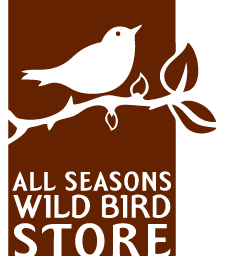We all love spring but sometimes dread the return of the blackbirds. Several species of birds are often casually lumped together into this group. The Icteridae family consists of all New World Blackbirds, Common Grackles, cowbirds, and even orioles but does not include European Starlings. You can be selective about which birds you feed by choosing specific bird food and feeders.
European Starlings are a non-native species and are not related to our native blackbirds. Starlings’ feathers are iridescent black with speckles and their beaks are dark in winter and yellow in spring and summer.

Avoid using open tray, platform or hopper feeders when starlings and grackles are a problem. Their bill-sweeping behavior sends lots of seeds flying to the ground, wasting a lot of seed. Instead use tube feeders, upside down suet feeders, weighted feeders or caged feeders to be selective about which birds you feed.

European Starlings preferred diet is insects and berries but they will feed from suet and seed feeders. Their beaks are softer and not designed for cracking hard-shelled seeds. Seeds out of the shell, peanut pieces and suet are easier for them to eat.
To deter starlings, use Bye-Bye Starling, which features all hard-shelled seeds including black oil sunflower, safflower and striped sunflower. Another seed option is to use only white safflower in the feeder which also deters grackles and Red-winged Blackbirds.
Avoid any seed mix with milo as blackbirds seem to be the only ones that eat it! Serving a straight seed like black oil sunflower, white safflower or Nyjer® also keeps birds from picking through the seed for their favorites as they do with seed mixes.
Other tips: use in-shell peanuts rather than peanuts out of the shell. Don’t put out kitchen scraps, bread, crackers etc.

Tube seed or Nyjer® feeders with shorter straight perches or mesh tubes without trays work well deterring larger birds while still feeding chickadees, House Finches, and American Goldfinches.

Use of an upside-down suet feeder makes it harder for starlings and grackles to eat the suet. This feeder has a roof over the top and the suet can only be accessed from underneath. The legs of grackles and starlings are not designed for hanging for extended periods but woodpeckers, chickadees and nuthatches can access the suet easily.

A caged suet or seed feeder prevents larger birds from entering as well. Smaller birds can enter the wire cage around seed or suet feeder easily, however; cardinals are reluctant to use them. These feeders will keep out gray squirrels and larger birds but not chipmunks and red squirrels. Choose one with the feeder portion several inches from the outside cage so birds can’t reach the seed with their long bills.

Using squirrel-resistant feeders that are designed to close off the access to the seed ports based on the weight of the squirrel or bird work well to prevent grackles and Starlings from feeding. Choose a feeder that allows for the manual adjustment of the tension setting. These can be set to close off the seed ports with very little weight. These larger birds may weigh 3-4 times as much as a chickadee or finch. Grackles weigh 3.9oz while cardinals weigh 1.5oz. We recommend the Squirrel Buster Plus, Legacy or Standard.
A final note concerns housing. European Starlings are notorious for taking over nest boxes from other cavity nesters. Nest box/bird house entrance holes should be no larger than 1.25”-1.5” to keep starlings out. Add a metal portal guard to your houses to keep birds from pecking the opening to make it larger. Remove any perches from nest boxes. Smaller birds don’t need perches and will fly right into the hole. The perches allow predators and starlings to hang on to the nest boxes as they attempt to enlarge the hole or reach the eggs or young inside.
With some thought and creativity you can enjoy your favorite backyard birds and be selective about who is welcome at your buffet.
By Minnetonka Manager CAROL CHENAULT

